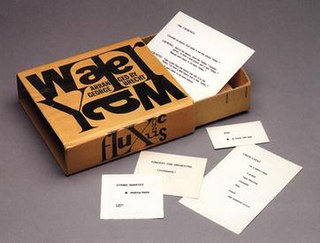Our website is made possible by displaying online advertisements to our visitors.
Please consider supporting us by disabling your ad blocker.
Water Yam (artist's book)

Water Yam is an artist's book[1] by the American artist George Brecht. Originally published in Germany, June 1963[2] in a box designed by George Maciunas and typeset by Tomas Schmit, it has been re-published in various countries several times since. It is now considered one of the most influential artworks released by Fluxus,[3] the internationalist avant-garde art movement active predominantly in the 1960s and '70s. The box, sometimes referred to as a Fluxbox or Fluxkit, contains a large number of small printed cards, containing instructions known as event-scores, or fluxscores. Typically open-ended, these scores, whether performed in public, private or left to the imagination, leave a lot of space for chance and indeterminacy, forcing a large degree of interpretation upon the performers and audience.
In some cases [event-scores] would arise out of the creation of the object, while in others the object was discovered and Brecht subsequently wrote a score for it, thus highlighting the relationship between language and perception. Or, in the words of the artist, "ensuring that the details of everyday life, the random constellations of objects that surround us, stop going unnoticed." The event-score was as much a critique of conventional artistic representation as it was a gesture of firm resistance against individual alienation.[3]
The work is considered an important precursor to conceptual art.
- ^ 'As a book, Water Yam has a very open structure ...' The Century of Artist's Books, Drucker, Granary 2004, p311
- ^ Fluxus Codex, Hendricks, Abrams 1989, p216
- ^ a b Dada and Radical Art Online
Previous Page Next Page


